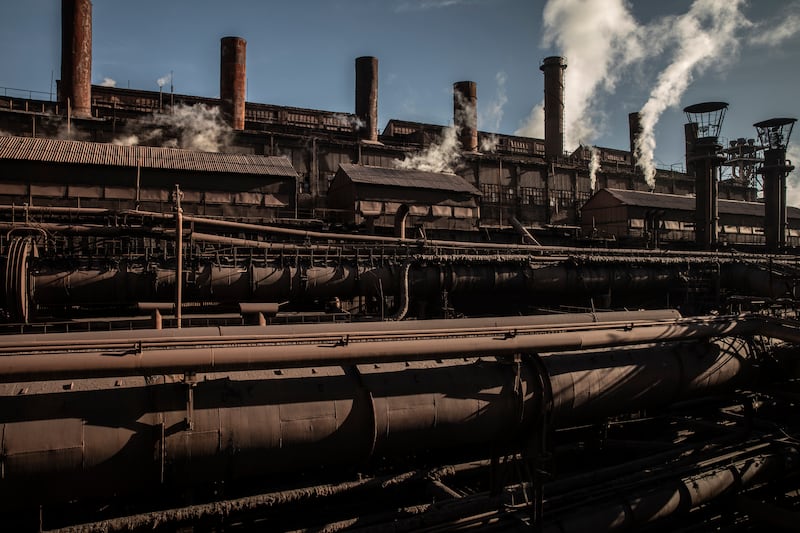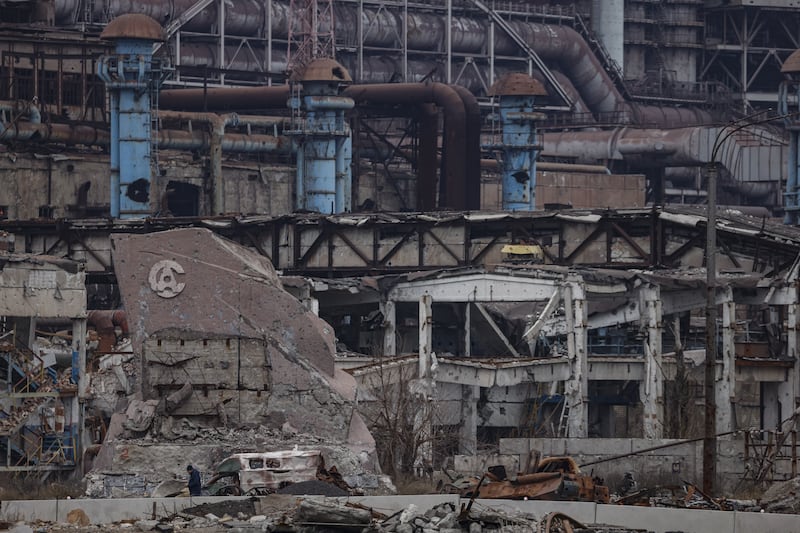Staff at Ukraine’s largest steelmaker, Metinvest, watched in horror last February as their security cameras showed invading Russian forces closing in on their factory.
But a lack of defences for their own industrial plants prompted an idea that has since taken on its own momentum: creating a Potemkin army. Metinvest’s hope is that the fake weaponry it now makes for the Ukrainian armed forces – tapping into a long military tradition of decoys – is luring Russia into wasting expensive resources destroying it.
As Russia invaded, “we dug trenches with our equipment and built fortifications around the plant. But we had no weapons,” recalled the enterprise chief of a Metinvest facility in central-eastern Ukraine, who spoke to the Financial Times on the condition of anonymity for security reasons.
“We used boxes, plastic, and any materials available here – even items discarded in the trash – that we could find to make decoy weapons,” he said. “We were outgunned but we made it look like our army was big and strong and that we were ready to fight. And we scared them off.”
READ MORE
Three senior plant managers realised Metinvest’s engineers could employ their skills to create realistic models of weapons used by Ukraine’s army to project a bigger and better-armed fighting force than the country actually had before the delivery of western arms.

A year and a half later, Metinvest has supplied more than 250 decoy weapons and pieces of equipment to Ukrainian troops across the frontline. A senior specialist, who also asked to remain nameless for security reasons, says they can now produce about 10-15 items a month.
Like the actual weaponry being used in Ukraine, the fakes undergo constant development. Manufacturers constantly “update” their designs and broaden their catalogue to fit the soldiers’ needs as new western weapon systems arrive.
[ Kyiv tries to heal rift with Poland as Russia attacks Ukraine power gridOpens in new window ]
[ Ukraine missile strike hits Black Sea fleet headquarters, says Russian officialOpens in new window ]
Other Ukrainian organisations and military units also produce decoys, including Soviet-era tanks employed by Ukraine’s army and models of US-provided High Mobility Artillery Rocket Systems, or Himars.
Metinvest workers in central-eastern Ukraine showed this month how they have honed their skills, producing increasingly realistic models of Soviet-era towed D-20 howitzers, American-made M777 howitzers, Ukrainian 35D6M radar systems, Lockheed Martin Sentinel A4 radars, mortar launchers and more.
They strive for “maximum authenticity” while producing the fakes as cheaply as possible, the enterprise chief says. Everything lying around the Metinvest factory is used: plastic tubes, foam blocks, used tyres, scrap wood and metal.
The enterprise chief chuckles as he notes that decoy radar reflectors are made from cut-up barrels from Russia’s second-biggest company, Lukoil.
The decoys must be light enough to transport easily but realistic enough to convince Russian forces – which use high-tech drones to spy on Ukrainian positions from the air – that they are legitimate targets.
“Our success is measured by the decoys’ destruction,” the enterprise chief says. “When they are destroyed it means we have saved our guns and our guys’ lives – and the enemy has wasted more of its valuable weapons.
“When they sit for too long we know we need to change the design.”
One recent modification was to include more metal on model howitzers, enabling the material, when heated up, to mimic the heat signals of real weapons firing dozens of rounds a day that could be registered by Russian thermal sights.
Militaries across the world have for decades used decoys to deceive their enemies in war. “But [deception] assumed a new importance in the 20th century as aircraft, radios and the ability to move more quickly drastically improved the speed at which reconnaissance could be conducted and enemy forces discovered,” says Mick Ryan, a retired Australian army major general and military analyst.
For example, he said, the allied withdrawal from Gallipoli at the end of 1915 employed a large deception plan over many weeks to convince the Turks that the Australian, British and other forces were staying in the peninsula.
[ Russian attacks kill nine in Ukraine as Moscow courts China, Iran, North KoreaOpens in new window ]
[ Ukraine retakes eastern villages as cargo ships defy Russia’s Black Sea blockadeOpens in new window ]
“The entire force withdrew without the Turks picking this up,” Ryan said. “It allowed the Allies to avoid casualties.”
Perhaps the best example is the massive programme in the lead up to D-Day to fool the Germans about where and when the invasion of Europe would begin.
“This involved dummy camps and equipment being built in England, fake radio networks being established, misleading stories being published in newspapers and fake commanders being installed in charge of a mythical army called the First US Army Group,” Ryan said.
More recently, the Iraqis used decoys in 1991 to confuse the American air campaign. Yugoslav forces in Kosovo employed crudely made fake artillery from wood and plastic tubes to trick Nato pilots. Armenia, meanwhile, duped Azerbaijan’s army with painted model surface-to-air missile systems in the Nagorno-Karabakh conflict in 2020.
Russia also has a decoy force composed of inflatable MiG-31 fighter jets, S-300 missile systems and battle tanks. The Ukrainians have poked fun at them for deflating on the battlefield.
The knock-offs made by engineers at Metinvest are more sophisticated.

The group is Ukraine’s largest producer of iron ore and steel, and owner of the Azovstal and Ilyich metallurgical plants, which were attacked and captured by Russian forces in Mariupol in the first months of the invasion. It is majority-controlled by Ukraine’s wealthiest man, Rinat Akhmetov, who personally supported the plant managers’ decoy idea.
“Every Metinvest employee is doing everything possible to save the lives of our soldiers on the front lines. The military decoys are just a small part of our contribution to the overall victory,” Akhmetov said.
Inside the decoy factory, workers saw, hammer and glue together pieces of a wood, foam and plastic tubing that would be eventually form a replica of a Soviet-era D20 howitzer. A half-completed version sat on one side of the hangar, while completed models of a D20 and an M777 stood nearby.
Even up close, the decoys are nearly indistinguishable from the real weapons and equipment they depict, an impressive feat considering the producers have never seen in person the military kit they are copying.
“We have never been to the frontline,” the enterprise chief says.
To achieve this realism, Metinvest’s workers study all the physical parameters of real military equipment using open-source information and created preliminary designs, reproducing all the subtleties of the original equipment down to the placement of nuts and bolts.
And where did they find the specifications for the weapons and equipment? “We Googled them,” says the enterprise chief. “It’s all on the internet.”
A lifelike Ukrainian D20 howitzer takes four days to produce, while an American M777 howitzer takes 14 days, a worker says. A Sentinel A4 radar copy requires up to three weeks, while the 35D6M radar is more complicated and can take a month.
The cost of each is between a few hundred and a few thousand euro – significantly cheaper than the sophisticated missiles, rockets and drones the Russians use to destroy them.
“Recently, Russian forces fired Kh-35 missiles with a cost of around €1 million to destroy a decoy radar system. We spent $1,000 on the decoy radar,” he said. – Copyright The Financial Times Limited 2023





















